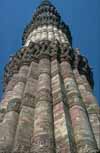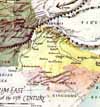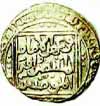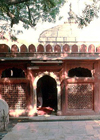|
|
 |
==Qutb
ud-Din Aibak and the Qubbat ul-Islam mosque: After a string
of earlier conquests, Mu'izz ud-Din Muhammad Ghuri annexes northwest Bengal
in 1204, but then his luck runs out and he is assassinated in 1206. Qutb
ud-Din declares himself an independent ruler, thus founding the Delhi Sultanate,
c.1206. To celebrate, he builds (or continues building) a Jama Masjid,
on the site of the old Lal Kot fort (renamed by Prithviraj, after himself,
the "Qila Rai Pithaura"). He destroys temples that he finds on the site,
and uses pieces of them as building material; local Indian craftsmen who
are hired to for the work also make their own contribution to the design.
This is not the first or the last time that a religious site in India is
destroyed/remade; in almost every case (including this one), the motive
seems to be political rather than religious. Two well-researched articles
on this subject by Richard M. Eaton: *one*;
*two*.
(As Sultanate Delhi comes to be called the "Qubbat ul-Islam" or "Refuge
of Islam," this name is extended to its chief mosque as well.) Images:
*Berger*;
*ANU*.
General background: *Sources
of Indian Tradition*. (*Routes*) |
 |
==The
Qutb Minar, symbol of Delhi: Qutb ud-din Aibak also begins
the building of a great victory tower, the Qutb Minar, which is also the
minar of his Jama Masjid. The style of the Qutb is Iranian, but local Indian
workmen incorporate looped bells and garlands and lotus borders into the
carving. The next ruler in the new Delhi Sultanate, Iltutmish (r.1210-36),
continues the work; the Qutb is repaired and embellished by later Delhi
Sultanate rulers as well. Its name comes from a later association with
the Sufi saint Qutbuddin Bakhtiyar Kaki. Images: *Berger*;
*ANU*.
Discussion: *I.
D. Mendis*; *India
Nest*; *Finbarr
B. Flood*. (*Routes*) |
 |
==The
Mongols sweep down from the north during this century and
overthrow settled states, kill hundreds of thousands, and threaten all
of Asia. Above all, they shatter the Muslim world; in 1258 Hulagu Khan
and his forces reach Baghdad and kill the last 'Abbasid Caliph. The Mongols
are a constant danger to South Asia, and the new Delhi Sultanate is forced
to guard its northwestern frontier at all costs. To help them do it they
have a constant influx of refugees fleeing from Mongol-dominated Central
Asia and Iran. For a pro-Mongol view: *Met*.
Discussion: *The
Mongols*; *Ikram
Chs. 3-4*. |
 |
==Sultana
Raziya (r.1236-40): The death in 1236 of Iltutmish, the second
ruler of the Delhi Sultanate, is followed by a succession struggle. His
capable daughter Raziya, whom he himself has groomed for power, seizes
the throne and struggles to keep it; but she is not accepted by the nobles,
and is eventually defeated and killed. |
 |
==the
Mongols sack Lahore (1241): In the chaos after Iltutmish's
death, the Mongols under Hulagu Khan break through the Sultanate defences
and sack and destroy Lahore, which remains almost deserted for years thereafter.
Not until 1270 does one of Iltutmish's successors, Balban, restore the
fortifications of Lahore and re-garrison the city; he also builds a strong
chain of new fortresses in the northwest. Like the Delhi fort, the Lahore
fort too contains many historical layers that all occupy the same general
site. |
 |
==Baba
Farid (d.1266), a Sufi of the Chishti order, is also popularly
called "Ganj-e Shakkar" ("Treasury of Sugar"). His official name is Shaikh
Farid ud-Din. He shuns Delhi and lives in retirement in his home town of
Pakpattan (Ajodhan) in the Punjab. There he composes devotional verses
that are the earliest examples of Punjabi literature. He is revered by
Sikhs too, since a whole set of his verses are included in the Guru Granth
Sahib: *sacred
texts*. |
 |
==Hazrat
Nizamuddin Auliya (1238-1325), a Sufi of the Chishti order
and Baba Farid's pupil, becomes a fixture in Delhi for most of his very
long life, and attracts devotees from every walk of life; he's one of the
most famous Sufis in South Asian history. His dargah and the neighborhood
around it are still centers of Delhi life (*alif
india*; *Time*).
A website maintained by some of his modern devotees: *Univ.
of Toronto*. Views of his dargah: *ANU*;
*archnet*.
A modern video: *Emory
Univ.* (*Routes*) |
 |
==The
Sun Temple at Konarak (c.1250): In Orissa, this detailed
and elaborately carved temple is built in the shape of the chariot of Surya,
the Sun, a god whose cult goes back to Vedic times. Originally it had seven
horses and twenty-four wheels, but not all survive. It has been described
as the summit of Orissan temple architecture and, for its size, the most
richly decorated temple in the world. Images: *Utah*;
*Berger*;
*DSAL*.
(*Routes*) |
 |
==Amir
Khusrau (1256-1325): The great Indo-Persian poet Amir Khusrau
is a devoted follower of Hazrat Nizamuddin Auliya. He is always proud of
his Indian origins, and boasts about them in his many works of Persian
prose and poetry. He also writes of composing some verses in "Hindavi"--
but only casually, to amuse his friends; and he doesn't bother to record
them. Many Urdu verses and riddles are nowadays attributed to him; but
alas, they comee from a much later period, and to call him "the father
of Urdu" is meaningless. A fine website devoted to him: *angelfire*.
A lovely illustration of one of his poems: *Met*.
His tomb is within the dargah of Hazrat Nizamuddin: *Time*. |
 |
==Trade
routes between Europe and Asia are maintained by all parties,
and continue to flourish under Mongol rulers as they have flourished under
earlier regimes. This large and very helpful map is a detailed overview
of how the world looks during the 1200's, and shows the main trade routes
by both land and sea. |
 |
==Namdev
and Jnanadev: These two Marathi bhakti poet-saints are part
of a distinct Maharashtrian bhakti tradition of devotion to Vitthal (or
Vithoba), a deity whose shrine is located in the town of Pandharpur. A
modern devotional account of these two saints' lives: *Swami
Shivananda*. Some of Namdev's verses are included in the Guru Granth
Sahib (for example, *sacred
texts*, parts 15-17). |
 |
==Marco
Polo stops by (c.1290): Marco Polo is believed to have landed
in Tamil Nadu and sailed up the Malabar Coast on his way back from his
long stay in China. More on his fabled (?) journey: *silk
road*. |
|
|













